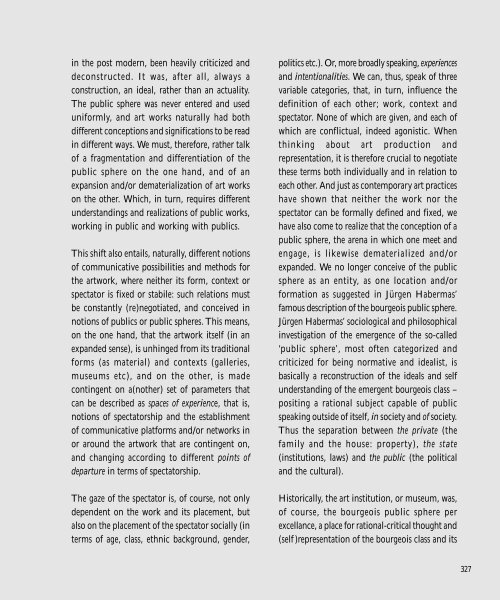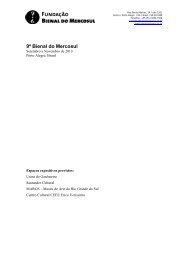Arte e Educação - Fundação Bienal do Mercosul
Arte e Educação - Fundação Bienal do Mercosul
Arte e Educação - Fundação Bienal do Mercosul
Create successful ePaper yourself
Turn your PDF publications into a flip-book with our unique Google optimized e-Paper software.
in the post modern, been heavily criticized and<br />
deconstructed. It was, after all, always a<br />
construction, an ideal, rather than an actuality.<br />
The public sphere was never entered and used<br />
uniformly, and art works naturally had both<br />
different conceptions and significations to be read<br />
in different ways. We must, therefore, rather talk<br />
of a fragmentation and differentiation of the<br />
public sphere on the one hand, and of an<br />
expansion and/or dematerialization of art works<br />
on the other. Which, in turn, requires different<br />
understandings and realizations of public works,<br />
working in public and working with publics.<br />
This shift also entails, naturally, different notions<br />
of communicative possibilities and methods for<br />
the artwork, where neither its form, context or<br />
spectator is fixed or stabile: such relations must<br />
be constantly (re)negotiated, and conceived in<br />
notions of publics or public spheres. This means,<br />
on the one hand, that the artwork itself (in an<br />
expanded sense), is unhinged from its traditional<br />
forms (as material) and contexts (galleries,<br />
museums etc), and on the other, is made<br />
contingent on a(nother) set of parameters that<br />
can be described as spaces of experience, that is,<br />
notions of spectatorship and the establishment<br />
of communicative platforms and/or networks in<br />
or around the artwork that are contingent on,<br />
and changing according to different points of<br />
departure in terms of spectatorship.<br />
The gaze of the spectator is, of course, not only<br />
dependent on the work and its placement, but<br />
also on the placement of the spectator socially (in<br />
terms of age, class, ethnic background, gender,<br />
politics etc.). Or, more broadly speaking, experiences<br />
and intentionalities. We can, thus, speak of three<br />
variable categories, that, in turn, influence the<br />
definition of each other; work, context and<br />
spectator. None of which are given, and each of<br />
which are conflictual, indeed agonistic. When<br />
thinking about art production and<br />
representation, it is therefore crucial to negotiate<br />
these terms both individually and in relation to<br />
each other. And just as contemporary art practices<br />
have shown that neither the work nor the<br />
spectator can be formally defined and fixed, we<br />
have also come to realize that the conception of a<br />
public sphere, the arena in which one meet and<br />
engage, is likewise dematerialized and/or<br />
expanded. We no longer conceive of the public<br />
sphere as an entity, as one location and/or<br />
formation as suggested in Jürgen Habermas’<br />
famous description of the bourgeois public sphere.<br />
Jürgen Habermas’ sociological and philosophical<br />
investigation of the emergence of the so-called<br />
‘public sphere’, most often categorized and<br />
criticized for being normative and idealist, is<br />
basically a reconstruction of the ideals and self<br />
understanding of the emergent bourgeois class –<br />
positing a rational subject capable of public<br />
speaking outside of itself, in society and of society.<br />
Thus the separation between the private (the<br />
family and the house: property), the state<br />
(institutions, laws) and the public (the political<br />
and the cultural).<br />
Historically, the art institution, or museum, was,<br />
of course, the bourgeois public sphere per<br />
excellance, a place for rational-critical thought and<br />
(self)representation of the bourgeois class and its<br />
327




